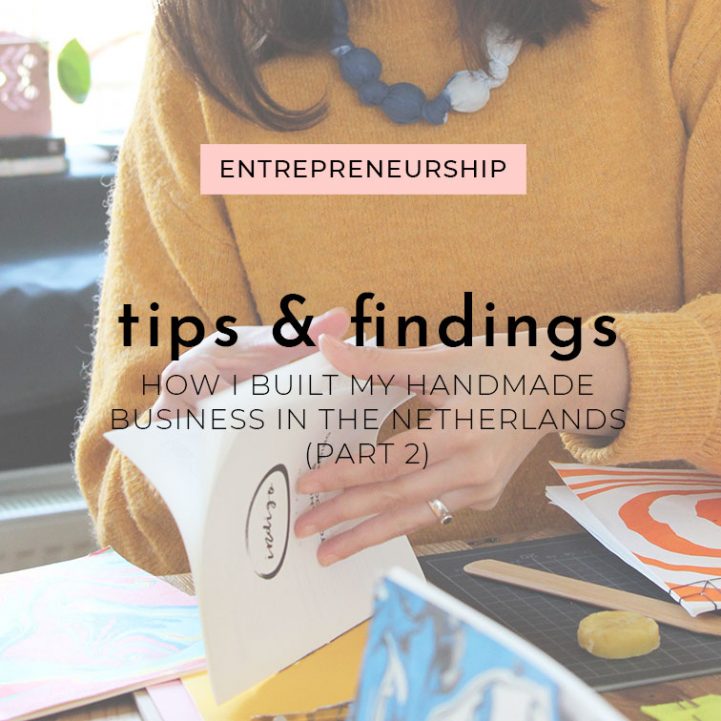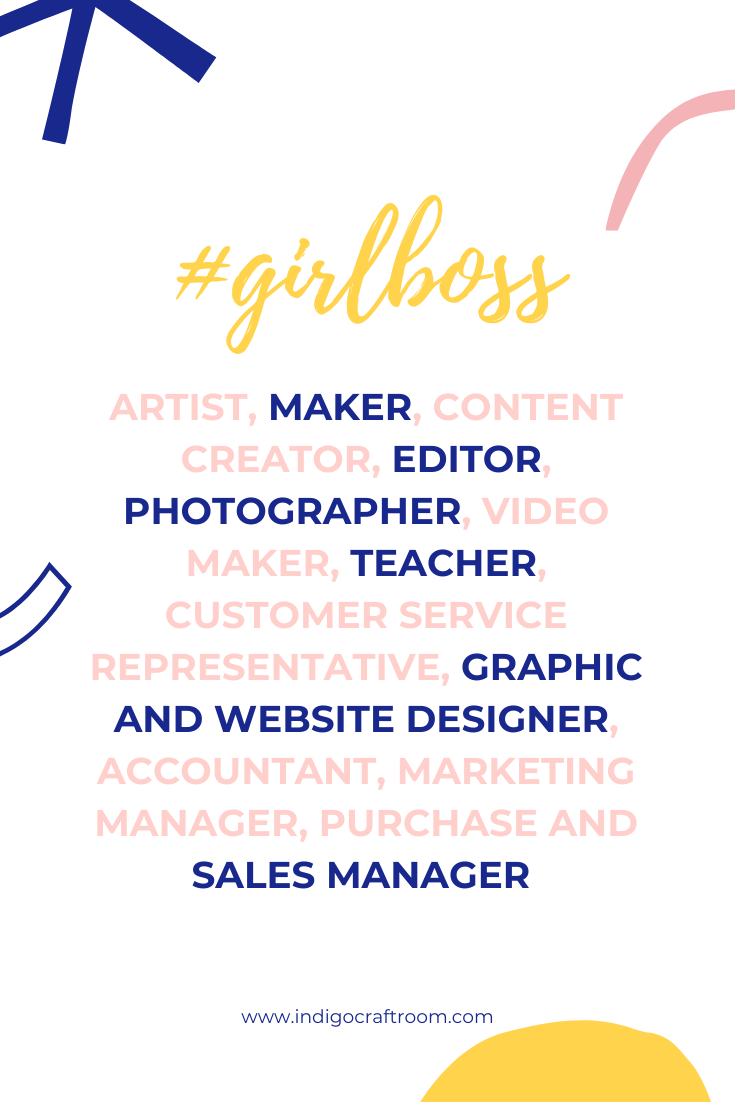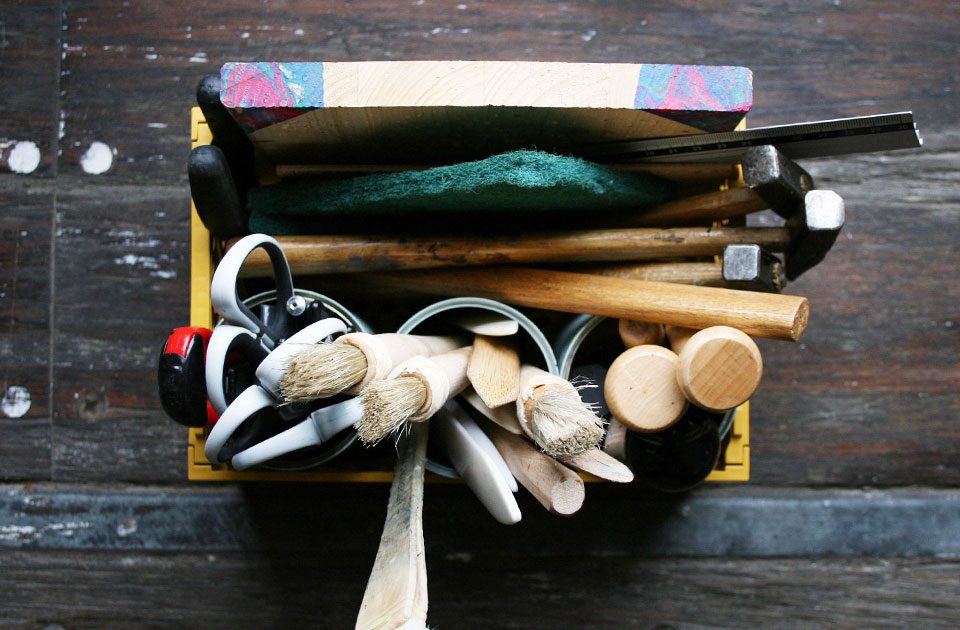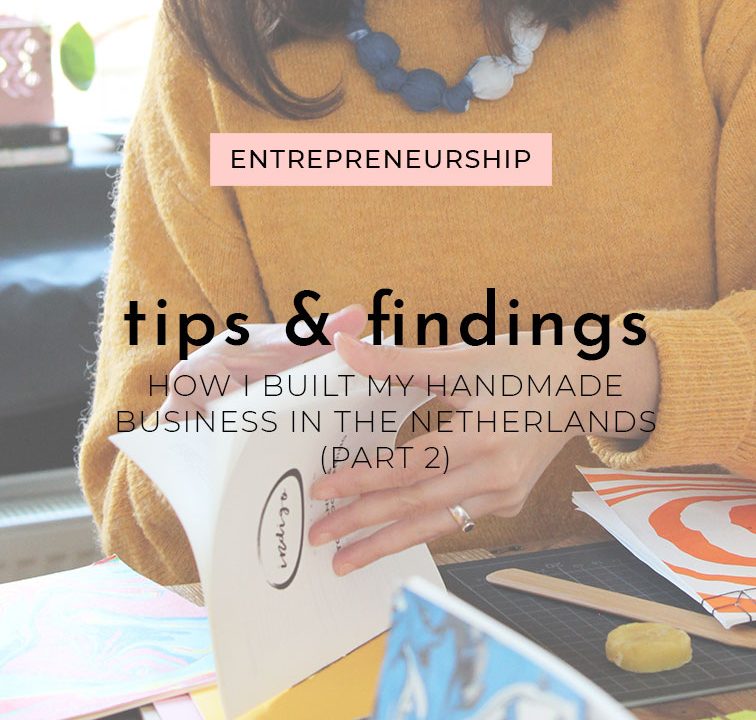
How I Built My Handmade Business in the Netherlands: Tips & Findings (Part 2)
19/07/2020
Girlboss 101: Planning & Organization Tips For Your Handmade Business
09/03/2021About three years ago I took the scariest step of my life so far. I started my own business:s and became a #girlboss. Many things have changed since then and although my small business isn’t yet profitable, so I can afford to live and pay all my bills just from that, I’m very proud of the brand I’m building and all the lessons I’ve learnt. For those of you who just started their own brand, or are considering to become an entrepreneur, I would love to share those learnings with you!
*** Please take into consideration that the recommendations shared in this post are based on my very own experience and therefore I cannot guarantee any success in your own endeavours. This is not a post with business or financial advice, but merely the story of how I run my own business.
So today’s topic is all about the tools I use to run my handmade business and other resources I found on my way of becoming an entrepreneur. Indigo Craft Room started as a handmade stationery online shop. Through the past three years, my business goals have changed and now I run an online shop next to my bookbinding and paper studio in Munich, where I also organize workshops and courses. Depending on the type of business you have or are planning to start, some of the tools I recommend here might be helpful or not, so keep that in mind.
As a solo-entrepreneur, I get to do lots of different things every day. Especially when you are starting and there is not so much money in the pocket, you have to be creative and acquire many skills you probably never considered to learn before. If I had to write a resume that described my job as an entrepreneur, it probably would include professions and positions like artist, maker, content creator, editor, photographer, video maker, teacher, customer service representative, graphic and website designer, accountant, marketing manager, purchase and sales manager… I can continue, but you get my point.
Hopefully, at some point of your journey as an entrepreneur, you will be able to hire some employees or work with other freelancers to support you in the areas that don’t relate directly with the things that you and only you can make. But until then, here are a few tools that can help you run your handmade business from day one.

-
PHOTO, VIDEO & EDITING
Big topic, especially if you are selling your handmade products. In today’s world, everything has to look instagrammable. Beautiful pictures, flat lays and videos. If you are a content creator, you know that the algorithm likes that.
From the very beginning, I started shooting my own product pictures and although I have booked a few professional photoshoot sessions, I cannot afford to hire a professional photographer every time I have a product to launch.
If you have a good smartphone, this could be enough for taking some pictures, especially for social media. I use both, my iPhone and a digital camera (nothing fancy, an old Canon DSLR). When taking pictures as an amateur, the golden rule is using natural light. I do all my product and social media pictures during the day and try to pick a spot next to the window. For quick editing I use Photoshop. If you use your smartphone, there are dozens of apps with lots of filters and editing options, from very easy-peasy to professional settings.
A few years ago I took this course from Domestika about creating photos for Instagram. This was a pretty good tip for the start and I can highly recommend it.
It can be discouraging when you start looking at the astonishing pictures you can find on Instagram or Pinterest. Give it time. You will get better!
Moving to video… This is still one of my work-in-progress skills. If you use Instagram, you probably know how to use IG Stories or Reels. I haven’t tried the last one, but I’m committed to show up more on video and record more stories. However, when it comes to longer DIY tutorials or content I want to produce for an online course or similar, I work with other tools.
Usually, I record the videos with my iPhone. I noticed that the quality of the audio isn’t that good, so I’m planning to get a microphone. You should use a tripod too, although I sometimes improvise with books, bottles or whatever I have at hand. Recently I took an online class from Yodomo where they teach how to shoot an online course and they have pretty good tips about video making.
There are many tools for editing video. I have an app installed on my phone called Quik. It’s very easy to use and perfect for editing short videos for social media. For my video tutorials, I used to work with an online tool called Clipchamp. It offers a basic subscription, which you can always upgrade in case you want to use more audio or video resources, or want to download your videos at a higher resolution. It’s great for making a few short videos from time to time, and mainly for those of you who have zero idea of video editing. If you want a professional tool with more editing options I will recommend you DaVinci Resolve. You can download this software for free and install it in your laptop or pc, but it requires a basic understanding of video editing.
Extra tip: If you need music for your videos, you can use the free library from YouTube. Make sure to check the copyright of the track you download!
-
GRAPHIC DESIGN
While studying journalism, I got to work a little bit with InDesign and Photoshop. Therefore I already knew a few basic concepts of design and could use the basic functions of InDesign for creating layouts, e.g. for the printed guides of my DIY Bookbinding Kits.
However, discovering Canva has been magic! This is an online tool with a free version that allows you to create all kind of graphics. Really, all kinds! From social media posts to newsletter and website banners, booklets, flyers… They have a huge database with pictures, graphics and of course, you can upload your own pictures. You can choose from thousands of designs, fonts, and colours. It can be overwhelming trying to pick just one.
I use the desktop version, but they also offer a mobile version. On my laptop works a little bit too slow… but I have an old laptop. Anyway, it’s for free, easy to use and really inspiring.
-
ORGANIZATION & PLANNING
I like a tidy desk. Off- and online. I’m well known for my (nerdy) organization skills and I’m sure Marie Kondo would tell me I can do it better, but so far I’m happy with my system.
As an artist and maker, you would think I spend all my day marbling paper and making books. Wrong. Most of our time as entrepreneurs is spent checking e-mails, processing orders, networking on social media, paying bills… So, let’s make it at least easy for us!
For making sure I don’t lose any important file I might need in the future, I do monthly backups to a Dropbox account and an external USB-drive. If you use Gmail, you can also create and save documents in Google Drive.
I hope you no longer use your high-school password for all of your online accounts. Nowadays you can work with tools like 1Password or Enpass for creating secure passwords and keeping them in a save place without forgetting any of them. Both tools work with a “master password”, which will grant access to the rest of the passwords you have saved.
When it comes to organizing my day and planning ahead, I like to use Trello. It’s actually designed for groups, but you can also use it as solo-entrepreneur. This tool has a free version that allows you to create different boards where you can plan and keep an overview of your projects and tasks. But more about it, daily routines and project planning, in another post. Stay tuned!
-
E-COMMERCE PLATFORM
Social media is focusing more and more on online shopping, and now you can sell via Instagram and Facebook without even having your own website or e-commerce platform. However, if you want to stand out of the crowd and have a professional online shop, at some point you will need to switch to something like WooCommerce or Shopify.
When I started Indigo Craft Room I didn’t know too much about e-commerce and online shopping, or website design. So I first went for an online platform called Mijnwebwinkel (it’s a Dutch platform, but I’m sure in your country there are similar ones). These kinds of e-commerce platforms offer pre-built websites and online shops that you can personalize by adding your brand colours, logo, images, etc. It isn’t easy, I won’t lie to you. It requires a basic understanding of e-commerce, design and tech-stuff.
That was a good start for me, but I wanted to have more control over the content and design of my website and online shop, so eventually, I decided to switch to WordPress and WooCommerce. It wasn’t easy. But I did it.
Most of the entrepreneurs ask for help at this point. Either hiring a website designer to set up the basics or to do all the work from the beginning. You will need anyhow some extra support, since you will need to register a domain, etc.
There are some online courses like this one from Domestika, where you can learn how to set up an online shop in WordPress. But even so, I would look for tech-help if you can afford it.
For handmade products, you could also create an Etsy account. It’s a bit confusing when it comes to transaction fees and taxes, but once you have cleared it, it can be a platform with awesome potential. Think that lots of people already know about Etsy and this way you can reach a new audience, which otherwise you could only reach via your own online shop after months or even years of hard work.
-
FINANCES
When we start small we forget that no matter the size of our company or the revenue we do every month, we are a company. And therefore we should keep our business and private finances apart. Not just for the purpose of taxes, but so you have a better overview of where the money comes in and where it goes.
I use online banking because it’s usually cheaper and I don’t really need anything else than my laptop and a credit card for doing business. While I was living in the Netherlands I had an account at ASN Bank, now in Germany I work with Holvi. Look for online banks that offer business accounts in your country, compare them and pick the one that suits you best.
If you are working with an e-commerce platform like WooCommerce of Shopify, you will probably accept other payment methods next to bank transfer or cash. I use PayPal for both payments via PayPal accounts but also for making payments with credit cards. I recommend you to open a business PayPal account, again to keep your private and business expenses apart. PayPal has very different fees, so I encourage you to check your statements every now and then, in order to know exactly what you are paying for each transaction and adjust your pricing strategy.
There are other alternatives for accepting payments with credit card like Mollie. This is a payment platform you can connect with your online shop in order to process payments in a secure way. You pay a transaction fee as well.
Last but not least, if you are an artist or maker with a store in the city or you attend handmade markets and fairs regularly, you might want to be able to accept direct credit- or debit card payments. There are portable credit card readers like iZettle. In this case, you also pay a transaction fee and you also have to buy the card reader.
-
TEACHING ONLINE
The pandemic pushed us to go online and adapt our routines and way of working, learning and experiencing creativity. I used to think I was an “online kind of person”, but last year I felt the fear of having to teach online. When it comes to workshops and teaching I’m a bit of a perfectionist and I’m afraid I won’t be able to offer the same learning experience compared to a real in-person workshop. But challenging times call for experiments, so last year I also did a couple of webinars and I’m planning new ones for the following months.
At this point, you probably have heard about Zoom. I believe all of us created a free Zoom account last year, didn’t we? This online tool is probably the most used right now for hosting webinars and other online events.
I also use Google Meet, which is a bit cheaper (you can use the free version but then all your attendees will need to sign up with a Gmail account). If you sign up for a G-Suite you will get access to Google Meet and all other online tools from Google Business.
For those of you considering creating and hosting an evergreen online course, this is, a course that participants can play automatically without you having to show up every time, you might find something like Teachable or Udemy interesting. I haven’t tried them yet, but they are very common.
Instagram seems to be also an easy-peasy and totally free way of hosting an online course. If your classes are for free, you could just organize an Instagram Live session that anybody can join. If you want to charge your participants for the class, you could create a separate private account and just grant access to those who have booked your course. I haven’t done it yet, because not everybody has or wants to sign up to Instagram, but depending on your audience this might actually be the perfect channel for them.
Extra tip: Remember the class from Yodomo I mentioned before. You will find other extra tips for hosting online classes there.
-
MARKETING & SOCIAL MEDIA
This topic could make five blog posts easily, but I’ll try to keep it short and to the point. If you are an entrepreneur or one in the making, you probably already know that social media is or could be an important marketing and sales channel for your brand. There are so many options and you might want to be everywhere. Wrong. You don’t have to be everywhere, but basically, be there where you decide to be.
As soon as you start brainstorming about your brand and products, you will need to define your audience, your potential customers. Here is where you can decide on which social media to be. Artists and makers can reach their perfect audience on channels like Instagram or Pinterest. If you focus on teenagers or young adults, TikTok or Snapchat might work better, and so on.
Opening a social media account is for free, but maintaining it and showing up there costs time. And time is money. Furthermore, there isn’t anything that scares away more customers than visiting a ghost account. If you don’t publish regularly and not just post and show up, but also offer quality content that inspires and helps your customers, your audience won’t engage with you and you won’t see any results in terms of reach, brand visibility or sales.
For Indigo Craft Room I opened a few social media accounts: Instagram, Facebook, Pinterest and YouTube. Each of them has a specific goal and purpose, although I realized that the one that works best for my brand is Instagram. There I can interact with my followers, gather inspiration, show behind the scenes and also market and sell my products. I still use all my other social media accounts, but less regularly and eventually for a different type of content or purpose.
Once you have a marketing strategy, the next step will be to plan and batch your content. Improvisation is a no-go for a long-term and successful brand visibility on social media. I have my ups and downs when it comes to planning content for social media, but when I get it I use tools like Later or Linktree to help me visualize and schedule what I want to share. Most of these tools have tons of resources with helpful tips about creating content, planning and more. Check their blogs!
So, being on social media, sure. Check and done. But should you also start your own e-mail list? I would say yes. And so will say many if not most of all marketing managers you ask.
I’ve read you should start your mailing list as soon as you create your brand and go live. The longer you wait, the more time and potential subscribers you are losing. But in my opinion, if you have nothing interesting to offer to your readers and you are not committed to delivering quality content regularly, you could wait until you get clear about your marketing strategy.
I started the Indigo Newsletter right away after I launched my website and online shop. That was almost 2 years ago or 25 monthly newsletters. I love writing and creating content and marketing has also become a skill I want to keep developing, not just for my brand but for my professional career in general. From the beginning I wanted the Indigo Newsletter to be a way of inspiring my subscribers and bringing them closer to my work and my art.
For e-mail marketing, I use Mailchimp, which is free up to a certain amount of subscribers and e-mails per month. There are many other alternatives, a quick Google search will give you a short overview of the different e-mail marketing providers in the market.
Creating and delivering a newsletter isn’t too difficult, but you will need to learn a few new words and concepts and read a little bit about it. If you use Mailchimp, they have lots of resources and tutorials.
Extra tip: A book that opened my mind about newsletters and e-mail marketing, Do Open: How a simple email newsletter can transform your business (and it can) by David Hieatt.
With the e-commerce world changing every day, it’s clear that we need to stay up-to-date if we want a piece of the cake. It’s impossible to be everywhere and be the first trying that new tool or social media channel. So choose wisely where do you want to show up, where do you want to talk to your audience and the tools that will help you to reach your goal and not the ones that will give you more headaches than anything else. Sometimes, starting and staying small is the most clever approach. But I will talk about that later on another post.
If you ever feel like talking about your business plans or you need a friend’s opinion, feel free to reach out. Send me an e-mail or contact me via Instagram. We can have a (digital) coffee and chat about our entrepreneurial endeavours!
Your crafty fellow,
Karen




